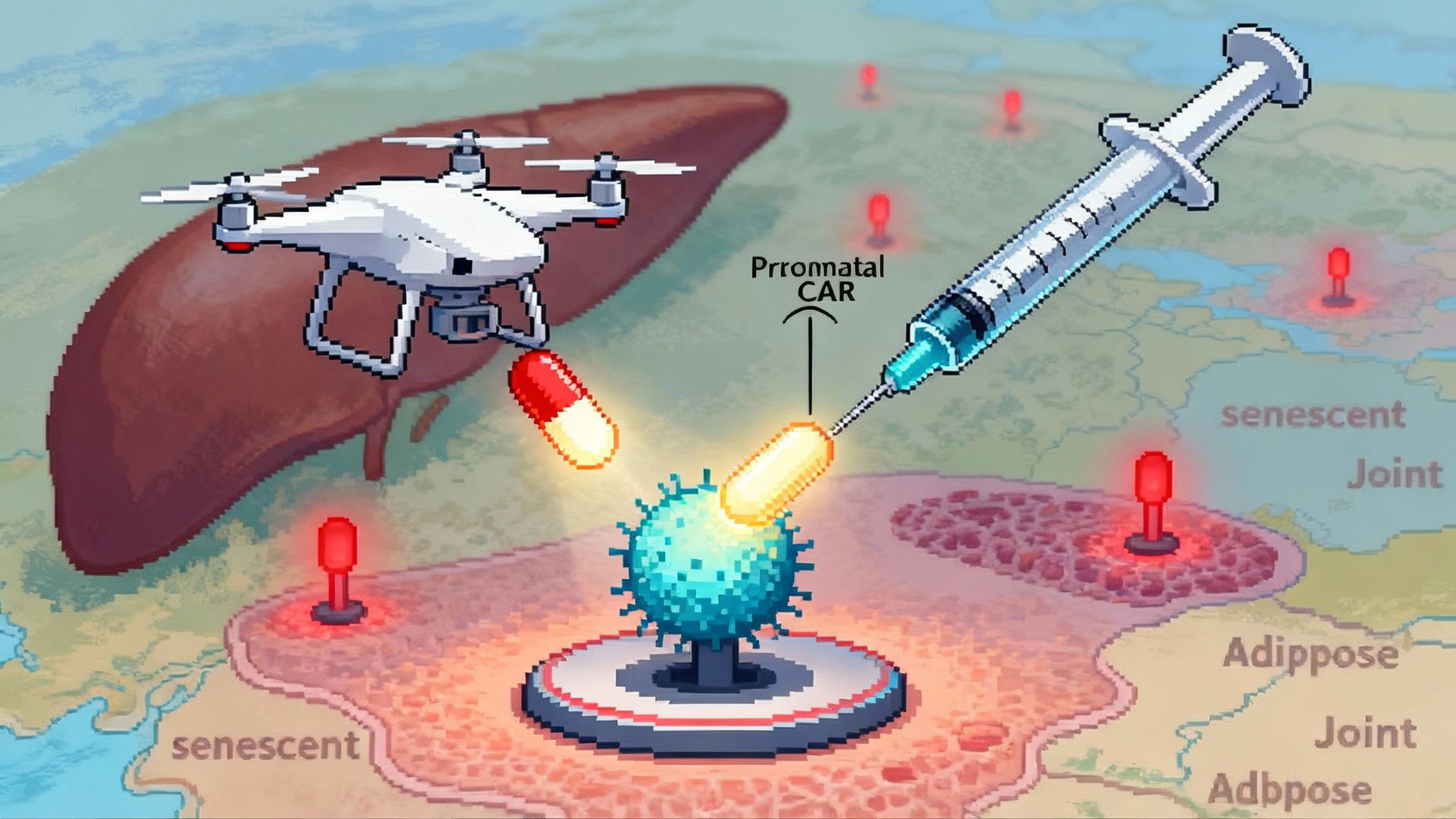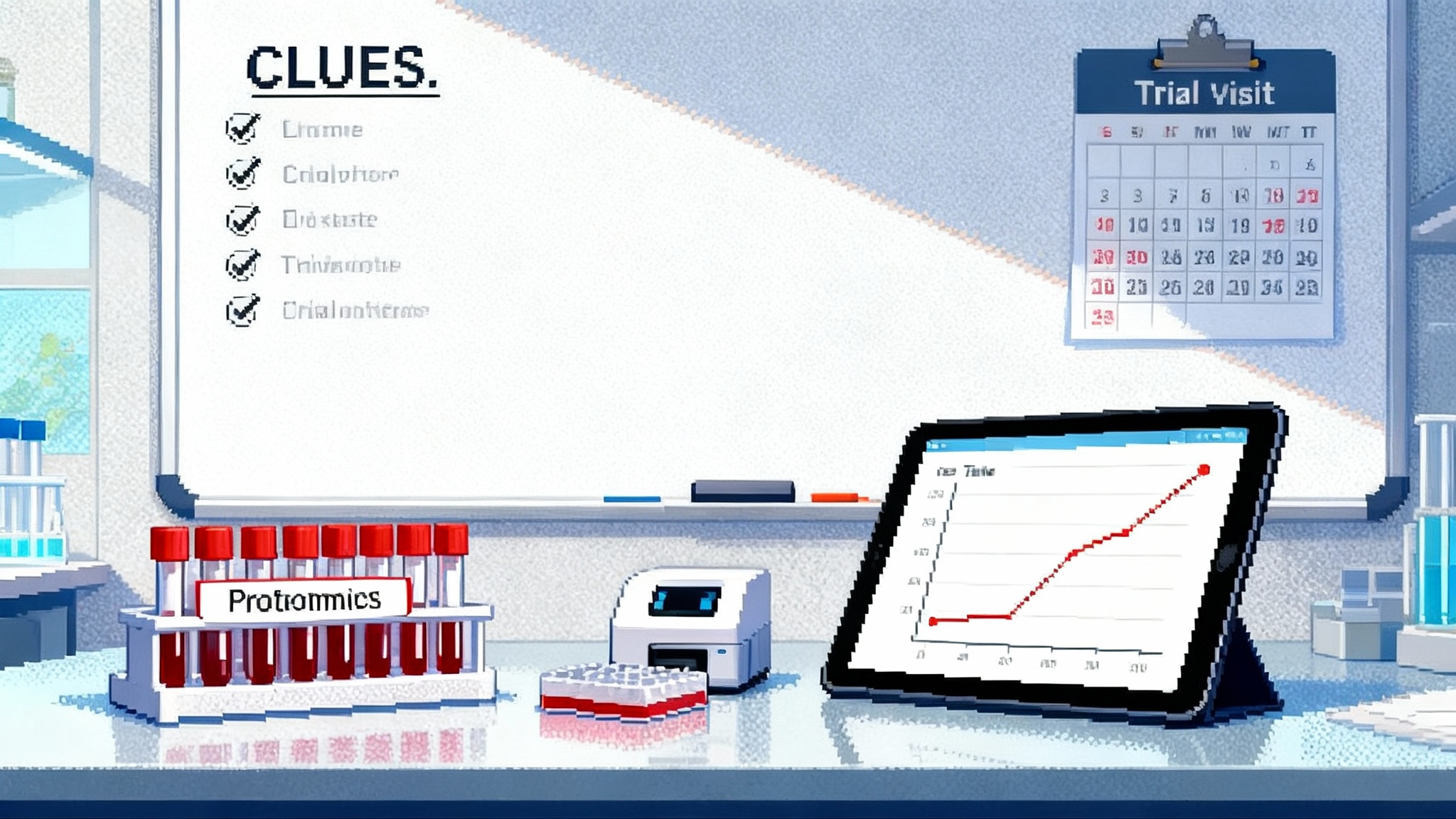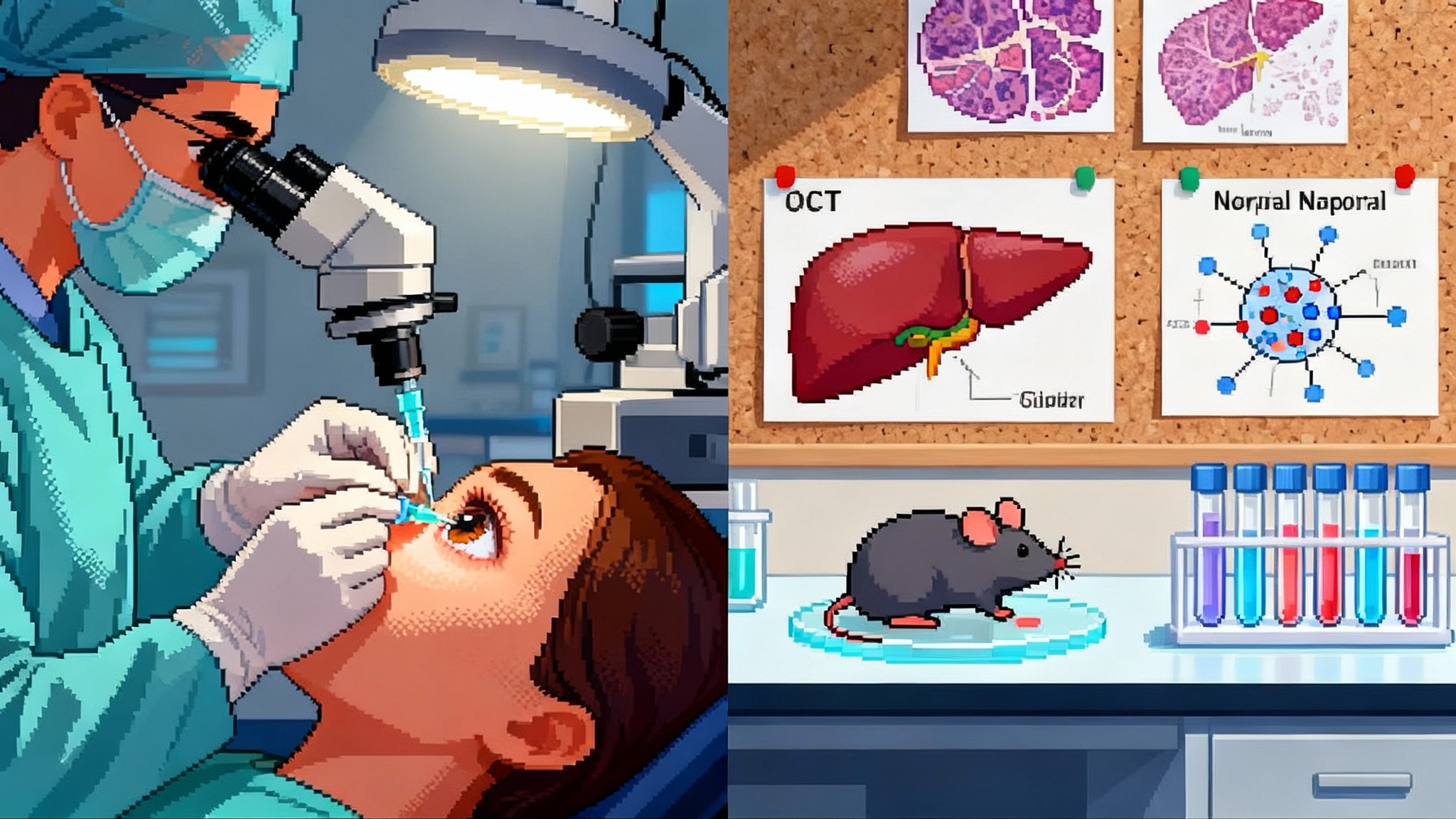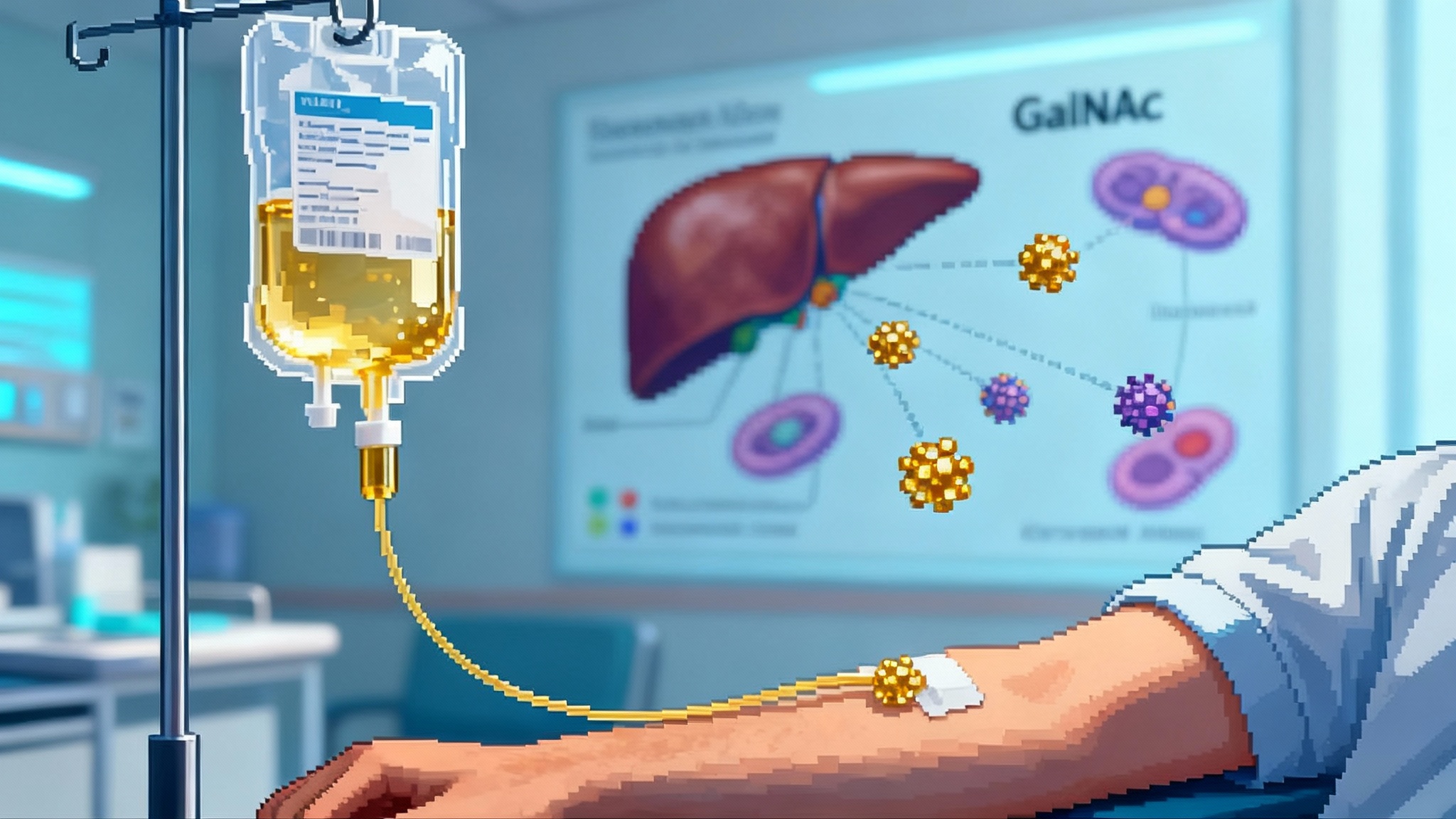In vivo CAR-T goes clinical: unlocking senescence therapy
September 2025 delivered two thresholds for cell therapy: the first human data that T cells can be programmed into CAR T in the body without conditioning, and the first randomized win for CAR T in a solid tumor. Together they open a credible path to senescent cell clearance in common aging diseases.

The moment the field has been waiting for
In September 2025, a small but decisive signal arrived: a first-in-human demonstration that messenger RNA inside lipid nanoparticles could program patients’ T cells into chimeric antigen receptor T cells directly in the body, deplete B cells, and improve autoimmune disease activity, with no chemotherapy conditioning. The report appeared as an ahead-of-print letter in the New England Journal of Medicine describing in vivo generation of CD19 CAR T cells and clinical improvement in systemic lupus erythematosus. It showed that the body itself can be the bioreactor, with dosing as simple as an infusion of a targeted nanoparticle carrying a short-lived genetic instruction rather than a months-long chain of apheresis, cell manipulation, and reinfusion. See the NEJM letter on in vivo CAR T.
If you have followed ex vivo CAR T for cancer or autoimmune disease, you know the trade-offs: spectacular potency for some targets and a price in time, complexity, and cost. In vivo programming promises to keep the potency while removing the bottlenecks. It is not simply a convenience upgrade. For aging biology and senescence, it could be the difference between a provocative mouse paper and a therapy people can actually receive. As small-molecule senolytics begin human testing, compare the trajectory in GPX4 senolytics move into humans.
ASCO 2025 moved the goalposts for solid tumors
Another signal came in June at ASCO 2025. A randomized phase 2 trial from China tested a claudin 18.2 CAR T therapy, satricabtagene autoleucel, in heavily pretreated gastric and gastroesophageal junction cancers. The trial met its primary endpoint with a progression-free survival advantage and showed a clinically meaningful overall survival trend, all with a manageable safety profile. It was the first randomized controlled success for CAR T in a solid tumor and it landed in The Lancet alongside the ASCO presentation. See the Lancet trial report on CT041.
There were other green shoots. A dual-target CAR T for recurrent glioblastoma, delivered into cerebrospinal fluid, shrank measurable tumors in a majority of patients in an early cohort. These are still early studies with relapse common, but the pattern is clear: engineering, delivery route, and target selection are making a dent in problems that defeated first-generation approaches. This mirrors the broader 2025 shift toward human testing summarized in 2025 pivot to first human trials.
Why this matters for senescence clearance and aging
Senescent cells are damaged, growth-arrested cells that persist and secrete inflammatory factors that accelerate tissue decline. Their accumulation contributes to fibrotic disease, osteoarthritis, and metabolic dysfunction. Clearing them improves tissue health in animal models, but doing it in people at scale requires precision and repeatability. Small-molecule senolytics have shown hints of activity, yet on-target precision has been hard to sustain and the effects often demand chronic dosing.
Two antigen families keep showing up as promising senescence beacons:
- NKG2D ligands such as MICA, MICB, and ULBPs. These stress ligands are broadly induced across senescent cell types in mice and nonhuman primates and can be engaged by CARs built on the NKG2D receptor.
- uPAR (urokinase plasminogen activator receptor). This surface protein is induced in senescence across multiple tissues and has supported elegant mouse data where uPAR-directed CAR T cells reversed liver fibrosis, improved metabolic markers, and boosted exercise capacity in aging models.
What was missing was a way to safely apply senolytic CAR T in humans at the scale of common diseases. If each dose requires personalized manufacturing and inpatient monitoring, osteoarthritis and metabolic syndrome are out of reach. In vivo programming changes the equation. Short-lived CAR expression means activity is tunable in time. Re-dosing is plausible in outpatient settings. The product can be standardized like a biologic rather than custom-built like a transplant.
From bespoke cars to over-the-air updates for T cells
Think of traditional CAR T like a custom race car: you pull a patient’s cells out of the garage, ship them to a factory, install a hand-built engine, then return the car for a single championship race. It works when the stakes justify the cost and schedule. In vivo CAR T is more like pushing an over-the-air update. The chassis stays home. You send software, the system installs a new mode, and after a few days the software uninstalls itself. If the road changes next month, you push another update.
That software-like property is why senolytic CARs get interesting in 2025. In fibrosis, osteoarthritis, and metabolic aging, the target is not a single tumor. It is a moving distribution of senescent cells across tissues that wax and wane with injury, lifestyle, and time. You want a therapy you can pulse, pause, and retarget without a three-month reset.
Who is building the toolchain
- Teams behind the September letter used antibody-guided lipid nanoparticles to deliver CAR mRNA to cytotoxic T cells in vivo, demonstrate functional B cell clearance, and report improvement in disease indices without lymphodepleting chemotherapy.
- Capstan Therapeutics, now acquired by AbbVie, advanced a CD8-targeted nanoparticle platform for in vivo CAR T, with a phase 1 healthy volunteer study designed to map pharmacology without conditioning. The corporate logic is straightforward: repeatable, off-the-shelf dosing and outpatient feasibility.
- Cartesian Therapeutics is pushing mRNA-engineered CAR T given as outpatient infusions without conditioning, illuminating a regulatory and clinical operations path for transient CAR exposure in autoimmune disease.
- Umoja Biopharma took a different route with in situ viral vectors, adding another material option for turning T cells into CAR T cells inside the patient.
- On the senescence antigen front, companies are lining up next steps. Programs aimed at NKG2D ligands appear in several pipelines, including efforts that explicitly list senescence as a potential application. Meanwhile, uPAR-targeted cells and related macrophage programs are progressing through preclinical liver fibrosis models that look increasingly translational.
The net result is a credible platform race: targeted nanoparticle delivery, in situ viral engineering, and ex vivo mRNA-transient CAR T all point to practical, repeatable ways to program immunity on demand.
Making senolytic CAR T feasible in three common aging conditions
- Fibrosis across organs
- Use case: recurrent pulses to deplete senescent myofibroblasts or stellate cells while sparing regenerative programs.
- Targets: uPAR for breadth in senescence-associated fibroblasts; NKG2D ligands for stressed cells in fibrotic niches; optionally add fibroblast activation protein for tissue selectivity with logic gating.
- Delivery: systemic nanoparticle dosing for liver and lung; regional arterial delivery for liver segments if needed; consider macrophage CARs to remodel extracellular matrix and present antigens.
- Endpoints that matter: elastic properties by magnetic resonance elastography; Enhanced Liver Fibrosis blood panel and bilirubin trends; for lung, forced vital capacity slope and quantitative computed tomography fibrosis scores. Avoid overreliance on single biomarkers like soluble uPAR without functional correlates.
- Osteoarthritis in weight-bearing joints
- Use case: local senescent chondrocyte and synovial fibroblast clearance to reduce inflammatory signaling and pain while buying time for cartilage repair.
- Targets: NKG2D ligand gating to handle heterogeneous senescence; uPAR where joint biopsies confirm upregulation; pair with chondroprotective biologics.
- Delivery: intra-articular dosing of targeted nanoparticles to limit systemic exposure; dose-cycled every few months if safety allows.
- Endpoints that matter: pain and function scales such as WOMAC and KOOS; quantitative MRI of cartilage thickness and T2 mapping; gait analysis. Biomarkers like matrix metalloproteinase fragments are supportive but should not be primary.
- Metabolic aging and fatty liver disease
- Use case: periodic senolytic pulses to reset inflammatory adipose niches and improve insulin sensitivity while diet and exercise do the heavy lifting.
- Targets: uPAR and NKG2D ligands in visceral adipose tissue and fatty liver.
- Delivery: low-dose systemic with careful monitoring for cytokine spikes; repeat dosing guided by glucose tolerance and liver fat fraction.
- Endpoints that matter: oral glucose tolerance test, homeostatic model assessment of insulin resistance, magnetic resonance proton density fat fraction for liver steatosis, and six-minute walk testing to capture functional change. For biomarker context and validation pressure, see the aging biomarker race after the FDA shift.
Why in vivo programming compresses cost and time
Ex vivo CAR T is expensive because each lot is a patient. The bill of materials includes apheresis, viral vectors, clean rooms, quality release, and cryoshipping, and the time cost can exclude fast-moving diseases. In vivo programming turns many of those fixed costs into a single scalable drug product. You manufacture a nanoparticle or vector at scale, standardize release testing, and ship vials rather than cells. Dosing can be repeated without repeating manufacturing. The system also creates a dial for duration by using messenger RNA that degrades in days, not months. For senolytics, where therapy may be maintenance rather than a one-time cure, that dial is everything.
The 12 to 24 month watchlist
Clinical and regulatory
- INDs for senescence-targeted CARs. Look for first filings that name uPAR or NKG2D ligands in indications like liver fibrosis, osteoarthritis, or metabolic syndrome. Early trials will be small, but the design language will tell you how seriously developers are balancing efficacy and safety.
- First safety readouts in noncancer aging indications. Expect conservative dose-escalation and a strong emphasis on cytokine release kinetics, liver enzyme profiles, and off-target tissue checks. Transient mRNA expression should enable rapid dose tuning across cohorts.
- Real endpoints beyond biomarkers. Regulators will expect function. In fibrosis, expect magnetic resonance elastography and forced vital capacity slopes; in osteoarthritis, pain and function scales complemented by quantitative MRI; in metabolic disease, glucose tolerance, hepatic fat fraction, and activity metrics.
Platform and delivery
- Targeted nanoparticle evolution. Antibody-guided or ligand-guided particles that home to CD8 T cells are the leading edge. Watch for human data on transfection efficiency, durability of CAR expression, and immunogenicity with repeat dosing.
- In situ viral vectors. VivoVec-like approaches will probe durability and tropism trade-offs. For senescence applications, reversibility and re-dosability will be the key questions.
- Logic-gated and regionally delivered CARs. AND and NOT gates to reduce on-target off-tissue effects, plus intra-articular and intra-arterial dosing to localize activity.
Business moves
- Strategic acquisitions and partnerships. The AbbVie-Capstan deal signaled that big companies want in vivo programming in-house. Expect more tie-ups that pair delivery platforms with tissue and disease experts in fibrosis and musculoskeletal medicine.
- Payer pilots for repeatable cell programming. Autologous cell therapy economics do not map to quarterly outpatient pulses. Health systems will experiment with bundled payments tied to function and hospitalizations avoided.
For how payers and regulators may pressure translational packages across longevity modalities, see 2025 pivot to first human trials.
The key risks and how to manage them
On-target, off-tissue effects
- Risk: uPAR and NKG2D ligands can appear in wound healing and acute inflammation. Clearing those cells could delay repair.
- What to do: use transient CAR expression with mRNA so exposure is measured in days; add logic gating that requires two signals; localize delivery when feasible; sequence therapy away from surgeries or acute flares.
Cytokine release syndrome and neurotoxicity
- Risk: even transient CAR activity can produce fevers, hypotension, or neurologic symptoms.
- What to do: predefine step-up dosing; use regional dosing for joints and specific organs; have rapid access to interleukin-6 blockade and steroids with clear thresholds; build outpatient monitoring protocols that mirror modern bispecific antibody programs.
Durability and re-dosing
- Risk: short-lived expression demands repeated dosing; anti-drug immunity could blunt later cycles.
- What to do: rotate nanoparticle chemistries and minimize highly immunogenic components; evaluate alternating targets for sequential pulses; measure neutralizing antibodies against delivery components and adjust schedules accordingly.
Heterogeneity of senescent cell biology
- Risk: senescent cells are not uniform, and some play beneficial roles in wound closure.
- What to do: pick indications with a high burden of persistent, pathogenic senescence; restrict to patients with imaging or biopsy evidence of target expression; monitor tissue repair markers and halt dosing if healing is impaired.
Manufacturing scale and quality
- Risk: moving from grams to kilograms of targeted nanoparticles breaks smaller manufacturing assumptions.
- What to do: invest early in scalable ionizable lipid synthesis, stable antibody conjugation, and reproducible release assays for particle size, encapsulation, and cell targeting; use human data to tighten specifications.
What to do now, and why
- Researchers: run tissue surveys in human fibrosis, osteoarthritis, and fatty liver to map uPAR and NKG2D ligand expression across disease stages. Co-develop assays with clinical teams so inclusion criteria are not guesswork.
- Clinicians: prepare trial pathways that treat in vivo CAR T like a potent biologic with day-one monitoring and day-two follow-up, not like a bone marrow transplant. Build fast triage for cytokine symptoms and nurse-led check-ins.
- Builders and investors: fund delivery science that reduces immunogenicity and increases targeting. Pair platforms with indications where regional dosing is practical, such as joints and liver segments, to cut systemic risk.
- Regulators: request function-first endpoints and preplanned stop rules tied to wound healing and infection risk. Encourage designs that compare local versus systemic dosing and logic-gated versus ungated constructs.
The bottom line
The field just crossed two thresholds. First, you can program human T cells into CAR T inside the body and see clinical benefit without chemotherapy. Second, CAR T can beat standard therapies in at least one solid tumor in a randomized setting. Put those together and a path opens for senolytic CAR T in diseases that affect tens of millions of people, not just thousands.
Getting there will take unglamorous work on delivery, targeting, and endpoints that matter in daily life. But the contours are now visible. Instead of building a bespoke cell product for each patient, imagine routine visits where a nurse administers a brief infusion that updates the immune system, clears a slice of pathological senescence, and then steps back. Do that safely and predictably, and senescence clearance moves from theory to therapy.








